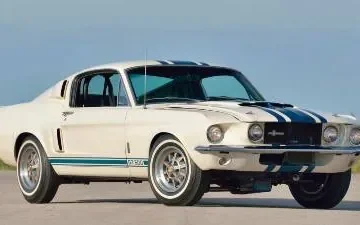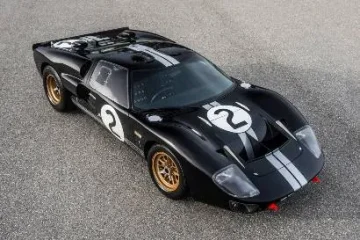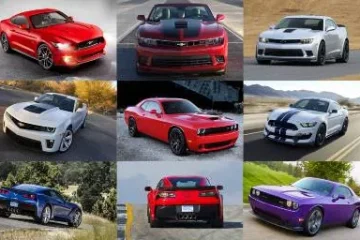The 1967 Pontiac Firebird debuted as a powerful and stylish muscle car, featuring a range of engine options and a design that set it apart from competitors. It quickly became an iconic symbol of performance and American automotive history.
Key Takeaway
The 1967 Pontiac Firebird became an instant classic by merging bold styling, a potent lineup of engines, and refined road manners. As Pontiac’s first answer to the pony car craze, it carved a unique identity that collectors and enthusiasts still revere today.
Contents
A Strategic Response To The Mustang
The Ford Mustang’s explosive success after its 1964½ debut sparked a revolution, forcing rivals to act quickly. General Motors responded with the Chevrolet Camaro and its upscale cousin, the Pontiac Firebird. Debuting in February 1967, the Firebird was Pontiac’s performance-forward take on the pony car formula.
Though it shared GM’s F-body platform with the Camaro, the Firebird featured Pontiac-specific styling cues: a split grille, arrowhead emblem, and chrome highlights that reinforced the brand’s sport-luxury image. Engineers tuned the suspension for a more refined ride, differentiating it further from its Chevrolet sibling.

Performance That Matched The Look
Under the hood, the 1967 Firebird offered five distinct powertrains tailored to varying buyer tastes. These included:
| Engine | Carburetor | Horsepower | Trim Availability |
|---|---|---|---|
| 230 cu in OHC Inline-6 | 1-barrel or 4-barrel | 165 hp (1-bbl), 215 hp (4-bbl) | Base, Sprint |
| 326 cu in V8 | 2-barrel | 250 hp | 326 |
| 326 cu in V8 High Output | 4-barrel | 285 hp | 326 HO |
| 400 cu in V8 | 4-barrel | 325 hp | 400 |
| 400 cu in V8 Ram Air | 4-barrel | 325 hp (claimed 335 unofficially) | 400 Ram Air |
Buyers could pair these with a 3- or 4-speed manual, or GM’s 2-speed Powerglide or 3-speed Turbo Hydra-Matic automatic. The top-tier 400 models borrowed engines from the legendary GTO, giving the Firebird street credibility from day one.
Better Road Manners
What set the Firebird apart was its suspension tuning. While muscle cars of the time emphasized straight-line speed, Pontiac added stiffer front springs, unique shock valving, and a rear anti-roll bar to improve balance. Reviewers at the time praised its confident cornering and smoother ride compared to competitors.
Distinctive Styling With Purpose
The 1967 Firebird turned heads with signature details:
1. Split front grille – a hallmark Pontiac design
2. Coke-bottle body lines – muscular yet elegant
3. Slit-style taillights – exclusive to Firebird
4. Rally II wheels (optional) – underscored its performance pedigree
Five trims were available: Base, Sprint, 326, 326 HO, and 400. Sprint models featured the high-output inline-6 and catered to buyers wanting sports car performance in a lighter package.
Interior And Driver Experience
Inside, the Firebird balanced sport and comfort. Bucket seats were standard, with optional woodgrain trim, center console, and full instrumentation. A deeply recessed dashboard, rally gauges, and 3-spoke steering wheel reinforced its performance feel.

Production Numbers And Collector Appeal
Pontiac built 82,560 Firebirds in 1967. Breakdown by trim:
– Base: ~15,528
– Sprint: ~18,917
– 326/326 HO: ~23,900
– 400: ~18,917
– Ram Air: ~65 (extremely rare)
Collectors today favor the 400 and especially the ultra-rare Ram Air models. According to Hagerty Valuation Tools, a concours-quality 1967 Firebird 400 can exceed $70,000 in value, while driver-quality examples range from $30,000 to $50,000.
Fun Fact: Firebird vs. Camaro
While built on the same platform as the 1967 Camaro, the Firebird offered:
– More refined suspension
– More upscale interior appointments
– A unique Pontiac performance identity
This helped attract a slightly older and more affluent buyer than the youthful Camaro crowd.
Expert Perspective
“The 1967 Firebird stood out because it wasn’t just a clone of the Camaro. Pontiac engineers wanted something more polished and powerful,” notes Jim Wangers, legendary Pontiac marketing consultant. “That car carried the soul of the GTO into a new, more affordable form.”

Conclusion: A Muscle Car Milestone
The 1967 Pontiac Firebird wasn’t merely a Mustang rival—it was a declaration of Pontiac’s performance DNA. With sharp styling, real power, and unique engineering touches, the first-year Firebird cemented its place as a muscle car legend. Its rarity, drivability, and legacy continue to draw collectors and fans nearly six decades later.
What Makes The 1967 Pontiac Firebird Special?
The 1967 Pontiac Firebird stands out due to its unique design, multiple powerful engine options, and its role in establishing Pontiac as a serious contender in the muscle car market. Its first-year production solidified its place as a classic.
What engine options were available in the 1967 Pontiac Firebird?
The 1967 Pontiac Firebird offered a variety of engines, including a 3.6L inline-6 (OHC and Sprint variants), a 5.3L (326 cu in) V8, and a 6.6L (400 cu in) V8 with optional Ram Air. This lineup gave buyers a wide range of performance choices.
How much horsepower did the 1967 Firebird 400 produce?
The standard Firebird 400 made 325 horsepower, while the rare Ram Air version delivered up to 335 horsepower with higher compression and freer-breathing intake components.
What makes the 1967 Pontiac Firebird different from the Chevy Camaro?
While the Firebird shared the GM F-body platform with the Camaro, it featured exclusive Pontiac styling, unique front-end design, engine choices like the overhead-cam inline-6, and upscale interior trim levels.
How fast was the 1967 Pontiac Firebird 400?
The Firebird 400 could hit 0–60 mph in around 5.8 seconds with the optional Ram Air package, putting it squarely in muscle car performance territory for its time.
How many 1967 Pontiac Firebirds were produced?
Pontiac built approximately 82,560 Firebirds for the 1967 model year, including both coupe and convertible versions.
What transmission options came with the 1967 Firebird?
Buyers could choose from a 3-speed manual, a 4-speed Muncie manual, a 2-speed Powerglide automatic, or a 3-speed Turbo-Hydramatic automatic, depending on engine selection.
How rare is the 1967 Firebird Ram Air model?
Extremely rare—only a small number of Ram Air-equipped Firebirds were built in 1967, making them highly collectible and valuable today.
What is a 1967 Pontiac Firebird worth today?
Values vary based on condition and originality. A standard model in good condition might fetch $30,000–$50,000, while a numbers-matching Firebird 400 or Ram Air version can reach $70,000–$100,000 or more at auction.
Is the 1967 Pontiac Firebird a good investment?
Yes, due to its first-year status, unique design, and strong enthusiast following, the 1967 Firebird is considered a solid classic car investment, especially rare or well-documented examples.
What are common restoration challenges for the 1967 Firebird?
Challenges include sourcing original Ram Air parts, maintaining the OHC Sprint engine, and locating correct interior trim pieces. However, reproduction parts are widely available for most compone
Sources:
Hagerty Valuation Tools: https://www.hagerty.com
GM Heritage Center Archives
Hemmings Motor News: https://www.hemmings.com
SlashGear: https://www.slashgear.com/1573252/1967-pontiac-firebird-what-engine-have-how-much-horsepower/




0 Comments